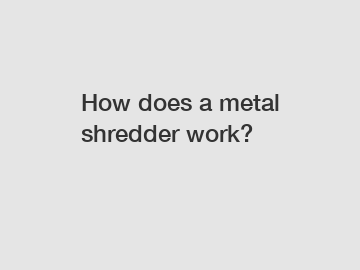How does a metal shredder work?
QIANSEN MACHINERY Product Page
Metal shredders, also known as metal crushers, are a crucial piece of equipment in the recycling industry. They play a vital role in reducing the size of scrap metal, making it easier to transport and process. But how exactly do metal shredders work? In this article, we delve into the inner workings of these powerful machines.
At first glance, a metal shredder may seem like a complex piece of machinery. But in reality, its operation is quite simple. The primary function of a metal shredder is to break down large pieces of metal into smaller, more manageable pieces. This is achieved through a combination of powerful blades, a motor, and a durable frame.

The first step in the shredding process is feeding the metal into the machine. This is typically done using a conveyor belt or a hydraulic cylinder. Once the metal is in position, the shredder's motor kicks into gear, providing the necessary power to drive the blades.
The blades of a metal shredder are designed to slice through metal with ease. They are typically made of high-strength steel and are shaped in such a way that they can effectively tear through even the toughest of materials. As the motor rotates the blades, they cut the metal into smaller pieces, gradually reducing its size.
As the metal is shredded, it falls through a series of screens or grates that help to control the size of the final output. These screens are crucial in ensuring that the shredded metal meets the desired specifications for further processing. Depending on the type of metal being shredded, the screens can be adjusted to produce different sizes of output.
In addition to shredding, some metal shredders also come equipped with features such as magnets or eddy current separators. These components help to separate ferrous and non-ferrous metals, allowing for more efficient recycling and processing. By removing unwanted materials, these features help to improve the quality of the shredded metal and make it easier to sell or reuse.
The efficiency of a metal shredder is dependent on a number of factors, including the type of metal being shredded, the size of the blades, and the power of the motor. Higher-grade metals such as steel or aluminum may require more powerful shredders with larger blades, while softer metals like copper may be processed with smaller, less powerful machines.
One of the key benefits of using a metal shredder is its ability to process large volumes of metal quickly and efficiently. This makes it an essential tool for recycling facilities, scrap yards, and metal processing plants. By shredding metal into smaller pieces, these machines help to save time, space, and money in the recycling process.
In conclusion, metal shredders are a vital component of the recycling industry. They work by using powerful blades and a motor to break down large pieces of metal into smaller, more manageable pieces. By controlling the size of the output and separating different types of metals, these machines help to improve the efficiency and quality of the recycling process. Whether you're looking to recycle scrap metal or process industrial waste, a metal shredder is an invaluable tool that can help you achieve your goals.
If you want to learn more, please visit our website Efficient ferrous metal crusher.



